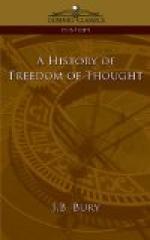A striking illustration of the gradual encroachments of reason is the change which was silently wrought in public opinion on the subject of witchcraft. The famous efforts of James I to carry out the Biblical command, “Thou shalt not suffer a witch to live,” were outdone by the zeal of the Puritans under the Commonwealth to suppress the wicked old women who had commerce with Satan. After the Restoration, the belief in witchcraft declined among educated people—though
[130] some able writers maintained it—and there were few executions. The last trial of a witch was in 1712, when some clergymen in Hertfordshire prosecuted Jane Wenham. The jury found her guilty, but the judge, who had summed up in her favour, was able to procure the remission of her sentence; and the laws against witchcraft were repealed in 1735. John Wesley said with perfect truth that to disbelieve in witchcraft is to disbelieve in the Bible. In France and in Holland the decline of belief and interest in this particular form of Satan’s activity was simultaneous. In Scotland, where theology was very powerful, a woman was burnt in 1722. It can be no mere coincidence that the general decline of this superstition belongs to the age which saw the rise of modern science and modern philosophy.
Hobbes, who was perhaps the most brilliant English thinker of the seventeenth century, was a freethinker and materialist. He had come under the influence of his friend the French philosopher Gassendi, who had revived materialism in its Epicurean shape. Yet he was a champion not of freedom of conscience but of coercion in its most uncompromising form. In the political theory which he expounded in Leviathan, the sovran has autocratic power in the domain of doctrine,
[131] as in everything else, and it is the duty of subjects to conform to the religion which the sovran imposes. Religious persecution is thus defended, but no independent power is left to the Church. But the principles on which Hobbes built up his theory were rationalistic. He separated morality from religion and identified “the true moral philosophy” with the “true doctrine of the laws of nature.” What he really thought of religion could be inferred from his remark that the fanciful fear of things invisible (due to ignorance) is the natural seed of that feeling which, in himself, a man calls religion, but, in those who fear or worship the invisible power differently, superstition. In the reign of Charles II Hobbes was silenced and his books were burned.
Spinoza, the Jewish philosopher of Holland, owed a great deal to Descartes and (in political speculation) to Hobbes, but his philosophy meant a far wider and more open breach with orthodox opinion than either of his masters had ventured on. He conceived ultimate reality, which he called God, as an absolutely perfect, impersonal Being, a substance whose nature is constituted by two “attributes”— thought and spatial extension. When Spinoza speaks of love of God, in which he considered happiness to consist, he means knowledge




